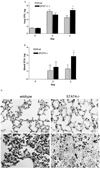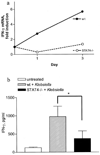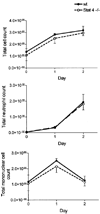STAT4 is a critical mediator of early innate immune responses against pulmonary Klebsiella infection
- PMID: 15356157
- PMCID: PMC3001230
- DOI: 10.4049/jimmunol.173.6.4075
STAT4 is a critical mediator of early innate immune responses against pulmonary Klebsiella infection
Abstract
Bacterial pneumonia is a leading cause of morbidity and mortality in the U.S. An effective innate immune response is critical for the clearance of bacteria from the lungs. IL-12, a key T1 cytokine in innate immunity, signals through STAT4. Thus, understanding how STAT4 mediates pulmonary immune responses against bacterial pathogens will have important implications for the development of rational immunotherapy targeted at augmenting innate immunity. We intratracheally administered Klebsiella pneumoniae to wild-type BALB/c and STAT4 knockout (STAT4-/-) mice. Compared with wild-type controls, STAT4-/- mice had decreased survival following intratracheal Klebsiella administration, which was associated with a higher lung and blood bacterial burden. STAT4-/- animals also displayed impaired pulmonary IFN-gamma production and decreased levels of proinflammatory cytokines, including the ELR- CXC chemokines IFN-gamma-inducible protein-10 and monokine induced by IFN-gamma. Although total lung leukocyte populations were similar between STAT4-/- and wild-type animals following infection, alveolar macrophages isolated from infected STAT4-/- mice had decreased production of proinflammatory cytokines, including IFN-gamma, compared with infected wild-type mice. The intrapulmonary overexpression of IFN-gamma concomitant with the systemic administration of IFN-gamma partially reversed the immune deficits observed in STAT4-/- mice, resulting in improved bacterial clearance from the blood. Collectively, these studies demonstrate that STAT4 is required for the generation of an effective innate host defense against bacterial pathogens of the lung.
Copyright 2004 The American Association of Immunologists, Inc.
Figures







References
-
- Rijneveld AW, Florquin S, Hartung T, Speelman P, van der Poll T. Anti-tumor necrosis factor antibody impairs the therapeutic effect of ceftriaxone in murine pneumococcal pneumonia. J. Infect. Dis. 2003;188:282. - PubMed
-
- Greenberger MJ, Kunkel SL, Strieter RM, Lukacs NW, Bramson J, Gauldie J, Graham FL, Hitt M, Danforth JM, Standiford TJ. IL-12 gene therapy protects mice in lethal Klebsiella pneumoniae. J. Immunol. 1996;157:3006. - PubMed
Publication types
MeSH terms
Substances
Grants and funding
LinkOut - more resources
Full Text Sources
Other Literature Sources
Molecular Biology Databases
Miscellaneous

